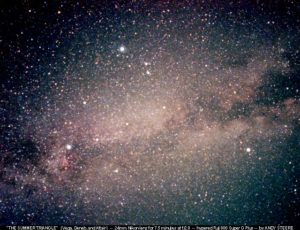The Winter Triangle

The Winter Triangle is an asterism, which is a group of stars that form a recognizable pattern, but are not officially recognized as a constellation. The Winter Triangle is formed by three bright stars in the night sky: Sirius, the brightest star in the sky, Procyon, and Betelgeuse. These stars are located in the constellations Canis Major, Canis Minor, and Orion, respectively.

The Winter Triangle is visible in the Northern Hemisphere from November to February and can be seen in the western sky just after sunset. It’s a convenient way for stargazers to find their way around the night sky, as the stars are bright and easily recognizable.
In addition to the three bright stars, the Winter Triangle also contains several other stars, clusters, and nebulae, making it a rich area of the sky to explore through a telescope or binoculars. So, if you’re looking for a fun way to enjoy the night sky during the winter months, the Winter Triangle is definitely worth a look!

Is the Winter Triangle visible from the southern hemisphere?
Yes, the Winter Triangle is also visible from the Southern Hemisphere, although it appears in the opposite part of the sky. In the Southern Hemisphere, the Winter Triangle can be seen in the eastern sky, just before sunrise, during the months of May to August. However, its visibility may be affected by the location’s latitude and the presence of light pollution.
For stargazers in the Southern Hemisphere, the Winter Triangle provides an easy way to find some of the brightest and most recognizable stars in the night sky, making it a great starting point for exploring the universe. So, whether you’re in the Northern or Southern Hemisphere, the Winter Triangle is a great way to get started with stargazing!
The Old Farmer’s Almanac considers the Dog Days to be the 40 days beginning July 3 and ending August 11. These are said to be the hottest days of summer.
Top of Form
In ancient Greece, Egypt, and Rome, it was believed that the dawn rising of Sirius in mid- to late summer contributed to the extreme weather of the season. In other words, the “combined heat” of super-bright Sirius and our Sun was thought to be the cause of summer’s sweltering temperatures. The name “Sirius” even stems from Ancient Greek seírios, meaning “scorching.”
For the ancient Egyptians, the dawn rising of Sirius (known to them as Sothis) also coincided with the Nile River’s flood season. They used the star as a “watchdog” for that event. Betelgeuse is the second brightest star in the constellation Orion. It is on the right shoulder and red in color. It is easily visible in the evening sky. The name Betelgeuse is from the Arabic “Yad al Jauza” – the hand of Al Jauza (Orion). In the last few years Betelgeuse has been getting brighter and then growing dim, as though some event like an explosion is about to happen.





